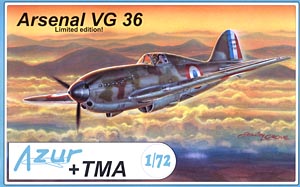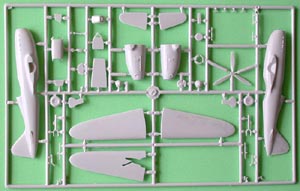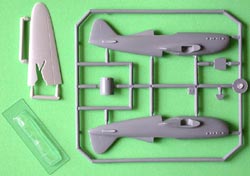Azur’s 1/72 Arsenal VG.36
By Chris Banyai-Riepl
 |

 |
 This kit, like the original, borrows from the earlier VG.33 kit produced by the same company. As such there are lots of extra parts in this kit, including a complete separate fuselage and a separate nose, all ready to be consigned to the spares box. In addition to the plastic parts you also get a small photoetch fret and two vacuformed canopies. Since there was only one built, the decal sheet is appropriately small, but includes all you’d need.
This kit, like the original, borrows from the earlier VG.33 kit produced by the same company. As such there are lots of extra parts in this kit, including a complete separate fuselage and a separate nose, all ready to be consigned to the spares box. In addition to the plastic parts you also get a small photoetch fret and two vacuformed canopies. Since there was only one built, the decal sheet is appropriately small, but includes all you’d need. Once the interior is together and sandwiched in between the fuselage, the rest of the construction is very straightforward. The fuselage is split into right and left halves and incorporates all of the vertical fin & rudder. The large radiator intake is a separate piece, as is the small scoop underneath the nose. The wings are split into upper and lower halves while the tailplanes are one piece, with both having a butt joint to the fuselage. The propeller is made up of four pieces, and the final bits left are for the landing gear. The gear should be sturdy enough, with a two-fork arrangement going around the wheels. You have an option of either using the plastic oleo scissors or the photoetch ones.
Once the interior is together and sandwiched in between the fuselage, the rest of the construction is very straightforward. The fuselage is split into right and left halves and incorporates all of the vertical fin & rudder. The large radiator intake is a separate piece, as is the small scoop underneath the nose. The wings are split into upper and lower halves while the tailplanes are one piece, with both having a butt joint to the fuselage. The propeller is made up of four pieces, and the final bits left are for the landing gear. The gear should be sturdy enough, with a two-fork arrangement going around the wheels. You have an option of either using the plastic oleo scissors or the photoetch ones. Since there’s only one of these planes ever built, there are not many painting options. The instructions show a three-color French scheme of mid blue gray, brown, and khaki over light blue gray. French roundels are in all six locations, with the rudder painted in the national colors. The only other decals included are for the text found on the rudder identifying this as a VG 36 C1. The decals are very well printed and should have no problems at all going down.
Since there’s only one of these planes ever built, there are not many painting options. The instructions show a three-color French scheme of mid blue gray, brown, and khaki over light blue gray. French roundels are in all six locations, with the rudder painted in the national colors. The only other decals included are for the text found on the rudder identifying this as a VG 36 C1. The decals are very well printed and should have no problems at all going down.